Be Vigilant with Your Child’s Oral Health
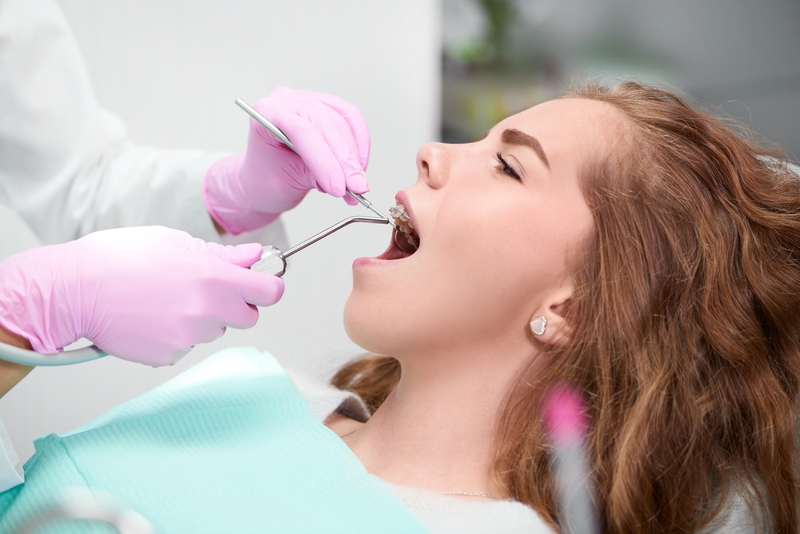
More than half the people that wear braces are children and teens. This can be an exciting time for kids to fix bite problems and crooked teeth. However, tooth decay and oral health problems also run rampant during braces if oral hygiene guidelines aren’t followed. Sometimes children and teens need a nudge to help them with their oral health. Find out what they should be doing to care for their braces during this time!
Facts About Braces
Did you know that there are over 4 million people in the United States each year that wear braces? About 1/4th of those are adults and the rest are children and teens. Patients use braces as teens to straighten the adult, permanent teeth that have come in. When children have child orthodontics, those brackets and wires are meant to correct bite and alignment issues that could cause a child severe problems in the future. Children can then straighten their permanent teeth later on.
There are common oral health problems that many children face today. It’s called tooth decay, and the National Institutes of Health reports that it’s the most “prevalent, chronic disease” among children and adults. 42% of children will have tooth decay before they are 12. 23% of those will have untreated dental decay. About 92% of adults have had tooth decay sometime in their life. The worst part about this is that tooth decay is completely preventable if a child, teen or adult has good oral health through practicing proper oral hygiene.
It may take several years for a child to have the right dexterity in their hands to brush and floss correctly. That is why parents must take care of their child’s oral health when they are young, or it could lead to serious problems. Children rely on parents to help their mouth stay healthy. Even teens need to be told to brush and floss, as it’s something they often forget. These habits are especially important during braces, as oral health is most affected when there are brackets and wires on the teeth.
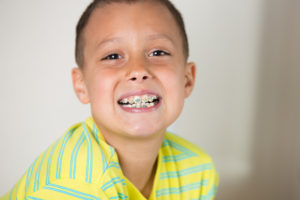
Helping Your Child’s Oral Health
The American Academy of Pediatrics recommends that children see a dentist around 1 year or within 6 months of their first tooth coming in. After that, they should go biannually to the dentist. This is how a dentist can start to see signs of bite and alignment problems, which are then referred to an orthodontist.
With some orthodontic appointments, a child can be fitted for braces to correct problems that are easy to fix with a young, moldable jaw, but hard to fix when a person is older and their jaws are set. Without braces, you will have to help your child brush and floss their teeth at least twice a day as the American Dental Association recommends. Use child toothpaste enhanced with decay-fighting fluoride and a toothbrush that fits the size of your child’s mouth.
Children will need to floss between their teeth, but might have to start out with flossers for kids. With braces, children should be brushing at least twice a day, but after every meal is even better. They should brush at 45-degree angles, making sure to move in all different directions to dislodge food that has been stuck in the braces. Flossing is incredibly important as well, as it gets 40% of tooth surfaces that are missed if flossing is skipped. Help them learn how to use threadable floss. This gets poked through the spaces between their teeth, pulled through, and flossed like you would normally do. Use a Christmas tree brush or a waterpik to help them dislodge stuck food.
Do You Have Good Habits?
One of the best ways to help your child with their oral health is to show them its importance through your own actions. If you don’t brush and floss your teeth, your child or teen may not either. When you’re also not visiting the dentist, odds are that your child isn’t either. If you eat a poor diet full of sugar, then your child will do the same. Children often copy what their parents do.
Make sure you are brushing your teeth at least twice a day, especially when your children can see you. Floss your teeth and teach them how to floss properly as well. When you need to go to the dentist, take your children with you and have them get their comprehensive exams and cleanings. All these oral health measures will ensure their mouths stay clean and healthy for years!
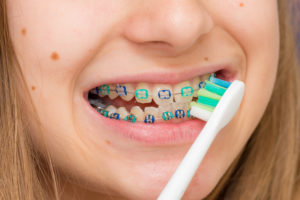
Other Factors to Consider
Your child can brush and floss their teeth often and may still end up with cavities. Cavities come from plaque in the mouth that has set on the teeth for too long. Your mouth makes plaque when you eat sugary foods and that sugar mixes with mouth bacteria to make acidic plaque. That acid is what causes the tooth decay. However, if you limit your sugar intake to begin with, you won’t have the problem with tooth decay.
Unfortunately, sugar is one of the most-consumed substances in the world. It is literally found in almost every food. That is why tooth decay is so common, especially in children. Limit your child’s sugar intake if you want them to have healthy teeth when their braces come off. Teeth that don’t get brushed or flossed often with braces, may end up having cavities, gum disease and eroded areas of their teeth when braces come off.
Their food can also leave them with squares on their teeth from the brackets, because the surrounding tooth has been damaged by food. Make sure to consider what your child is putting in their mouth if you want to help them have good oral health! For more tips or answers to questions about your child’s braces, call Belmar Orthodontics today at (303) 225-9016!
Child Orthodontics Compared to Adult Orthodontics
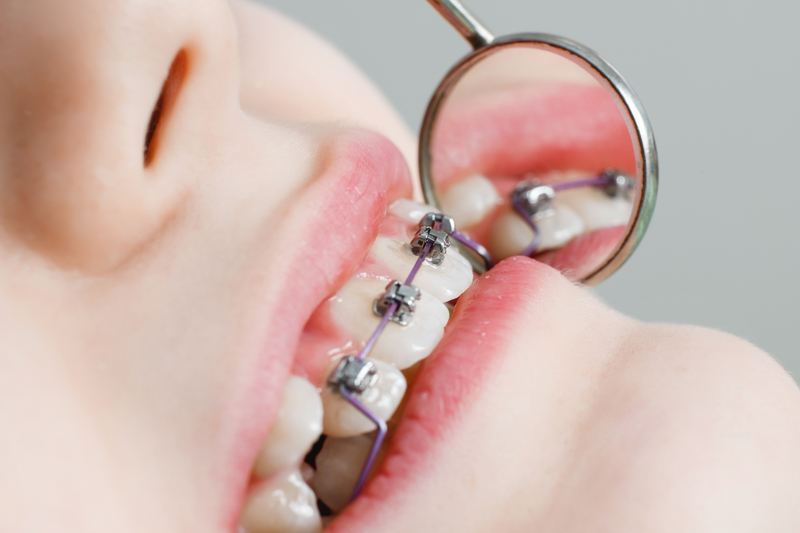
Did you know that about 1/4th of all people with braces are children? Millions of Americans receive orthodontic treatment for bite and alignment correction and for straightening the teeth. However, adults require treatment differently and for longer than a child would need, and child orthodontics have different goals for patients than adult orthodontics do. Both of these areas of orthodontics differ, but are also very similar in techniques used to create a beautiful smile.
Orthodontic Treatment
Orthodontic treatment is one of the easiest ways to help improve your health. Braces can help correct major oral health problems and can help avoid dental emergencies in the future. In children and adults, braces straighten the teeth so that they are aligned properly for speech, eating, biting and more. Straighter teeth are easier to clean and easier to manage, which leads to better health. Teeth must come in at specific places in the mouth for both children and adults. Child orthodontics focuses on that proper bite and tooth placement, and adult orthodontics seeks to improve the look of a smile.
Child Orthodontics
Did you know that children often wear braces, only to get them again as adolescents? Child orthodontics is a popular orthodontic option for at least 1/4th of braces wearers. Dentistry has been around enough centuries to know that the teeth, bite, alignment and growth happen in a specific way. Teeth must come in at the right spot and must be aligned in a specific manner in the jaw. As a child begins to get their baby teeth, some may be crooked. Depending on oral health conditions, and problems such as thumb-sucking, the shape of the teeth and bite can change.
Some children will have teeth that protrude outward, inward, or teeth that are in various directions. This leaves them open to the risk of broken or fractured teeth, tooth decay and problems with speech and development. Child orthodontics is the first phase of getting braces early. It focuses on getting the jaws lined up correctly and the teeth resting on each other in the right way. Once that happens, the baby teeth can fall out and the adult teeth can smoothly come into place. Child orthodontics will correct the major issues a child’s mouth has when they are around 7 or 8 years old. Starting at 11 and later, braces will seek to make the teeth look more attractive.
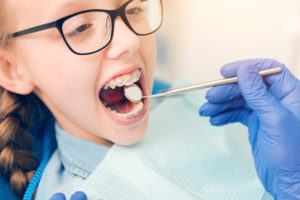
Adult Orthodontics
Most people think that teens make up the majority of patients with braces. However, adult orthodontics is very popular as well, with about 1/4th of all orthodontic patients being adults. There are more adults wearing orthodontic appliances than you realize, especially because of the “invisible options” they have that children don’t have.
Adults have a harder time with straightening their teeth than children do. By adulthood, the mouth and jaws have stopped growing, making them less moldable than a child’s jaws. The treatment that would have been easy for a child may take twice as long for an adult, or may require surgical orthodontics to achieve a straight smile, or proper bite and alignment. However, adults get the benefits of Invisalign treatment and lingual braces, which most children can’t have.
Invisalign is an “invisible” straightening option for adults and teens that uses a strong, clear aligner to straighten the teeth. Digital scanning creates customized aligners that a patient changes out ever 1-2 weeks, which slowly shift the teeth into their proper place. This invisible option allows adults and teens to brush, floss, eat and play sports without brackets and wires in the way. Lingual braces is another “invisible” straightening option. It has metal brackets and wires, except they’re placed on the back of the teeth. Only an adult can use these, as the baby teeth are not large enough for lingual braces to fit. Both adult orthodontics and child orthodontics correct bite, alignment and tooth issues, but the options available to the two age groups differ slightly.
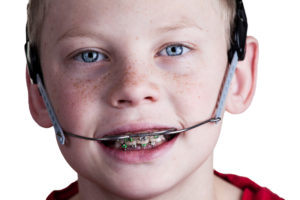
Why Choose Either Option?
When considering orthodontic treatment, there are various aspects you have to think about that include cost, health changes, aesthetic appeal and more. Many people think that braces are very expensive, when they are actually quite affordable. Your family may even save more money over time because of the oral health problems that are avoided by proper orthodontic treatment. A major reason so many people have orthodontic treatment is that they want to improve their smiles. Not only does a straight smile look beautiful, but it helps patients feel more confident. Studies show that child orthodontics helps children feel more confident in school and they do better academically.
Braces can correct speech problems caused by bite and alignment issues. They can straighten the teeth, making them easier to clean, and thus reducing problems with tooth decay, gum disease and bad breath. People socially perceive patients in a more positive way if their smiles are straighter and healthier. No matter if you choose orthodontic treatment for aesthetic appeal or for health reasons, the benefits are worth the time, effort and money you put into your treatment.
Conservative Treatment
Dr. Hardy practices a conservative approach to orthodontic treatment. While it is important for children to have an early orthodontic assessment to look for serious dental concerns (around age 7), the majority of children will not require orthodontic treatment before age 11. Your child might need child orthodontics or they may only need orthodontic treatment as a teen. Some people are naturally born with straight teeth that don’t pose them a problem, or their teeth start to shift later on in life. Whether your child needs child orthodontics or you need adult orthodontics, call Belmar Orthodontics today at (303) 225-9016 for your free consultation!
What Is Interceptive Orthodontics?
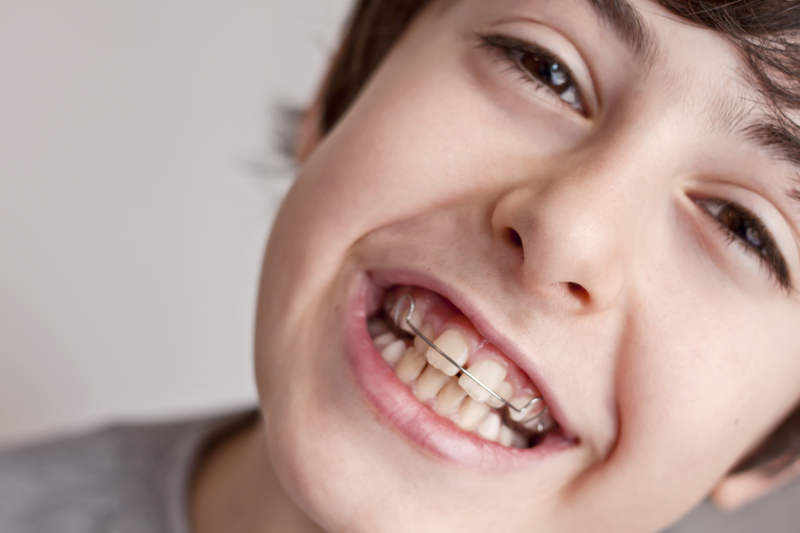
Millions of people each year receive interceptive orthodontics to correct bite and alignment issues. You may know these braces by the name of “child orthodontics” or “Phase 1” orthodontics. You might even know some children who have braces. Many children need orthodontic help to ensure that their bite lines up correctly for a healthy mouth. There are also other reasons a child might need interceptive orthodontics, such as receiving them to help make room in the mouth for the adult teeth to come in. Find out what interceptive orthodontics entail and if your child needs them!
Choosing to Get Braces
Many teens wear braces each year to straighten their teeth once the permanent, adult teeth have come in. Most permanent teeth have come into the mouth by age 12 or 13. However, braces aren’t only for teens who are wanting a straighter smile. In fact, about 1/4th of all people with braces are children and about the same amount are adults. Many more people than you would think wear braces, especially when “invisible” options like Invisalign and lingual braces exist.
When you choose to get braces, you are making a smart decision for yourself and for your oral health. Many people think that braces are only meant to help the teeth become straighter. Although that is one of the main reasons, there are many benefits of braces. These appliances are used to help fix crooked teeth, but also bites and mouth alignments that aren’t in proper position. There are orthodontic appliances when a patient only needs a few months to change a dental problem and there are even surgical options for orthodontics. But, why so many options when it comes to orthodontics?
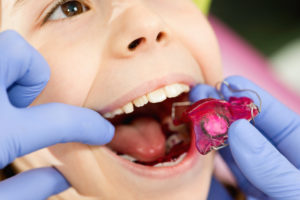
Benefits of Braces
We love to allow our patients the freedom to correct their smiles how they want, when they want. You are never too old to get braces. Children get them all the time to fix bite problems, only to get them again later on for straightening. Adults wear them, especially if they are wanting to advance their careers. Studies show that an employer is much more likely to take a potential employee if they have a straighter smile.
Orthodontic treatment is also proven to make people more confident in their smiles and in themselves. When patients get straighter teeth and fix dental issues, they smile more, talk more and exude more confidence. This can change someone’s entire life, especially a child’s.
What Are Interceptive Orthodontics?
Interceptive orthodontics is another name for “child orthodontics”. If you are surprised that children get braces, don’t be! The American Association of Orthodontics actually recommends that children have their first orthodontic visit between the ages of 7 and 8. This is when many of the baby teeth are falling out, and a perfect time to see how permanent, adult teeth are coming in. An orthodontist can use the first orthodontic appointment to check your child for bite and alignment problems before they become severe as a child ages into a teen and then an adult.
When certain orthodontic problems like crossbite or underbite, are left untreated, these conditions can become more severe, complicating issues. Interceptive orthodontics aims to check children while they are young for problems that will become severe in the future. They “intercept” a patient before that point, and fix the problem much easier than if a child’s mouth had grown more. Interceptive orthodontics checks children at an early age to:
- Observe the progress of incoming teeth
- Monitor facial and jaw development
- Guide incoming teeth into their ideal position
- Detect hidden dental issues
- Reduce the risk of impacted teeth
- Decrease the risk for permanent tooth extractions
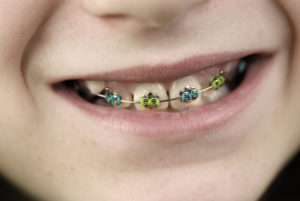
Considering Interceptive Orthodontics?
Do you want to give your child the best chance possible to have a healthy mouth? Make sure you involve an orthodontist in their early-childhood development! Interceptive orthodontics is not needed for every child, but for the ones who need it, it can change their life. If a child has enough crooked teeth, it can create uneven pressure on those teeth when they bite and chew. This can lead to broken, fractured, chipped and cracked teeth. The teeth are also much harder to clean when they are crooked, leading to tooth decay and gum problems in young children.
If a child’s bite is not even or their alignment is off, it can also lead to broken teeth. When the baby teeth aren’t aligned correctly, the adult teeth won’t come in right. Children can have uneven bites form from thumb-sucking and similar habits that curve the teeth outward. This can create problems biting, chewing, talking, and more. Speech impediments can form and become worse over time if the problem isn’t corrected. No parent wants speech problems, tooth decay or dental injuries to happen to their child, and they never have to. Call Belmar Orthodontics today at (303) 225-9016 for your child’s comprehensive orthodontic exam and see if they need interceptive orthodontics today!
The Best Ages for Having Braces

If you have a desire to get braces, we commend you for choosing to have a better smile! Studies show that a better, straighter smile can increase your confidence, success and professional life. However, there are some key ages that having braces are the best for patients. If you have bite and alignment issues, it’s best to receive child orthodontics. For straightening, the teenage years are the best for wearing having braces. However, braces can benefit patients at any age and may even be needed more than once in life. Find out what orthodontic treatment can do for you at any age!
Child Orthodontics
The American Association of Orthodontics recommends that children have their first orthodontic visit between the ages of 7 and 8. Having and examination early as a child will detect bite and alignment issues that can become severe later on in life. This early visit is something that you definitely want your child to receive, as bite and alignment issues can lead to problems with speech. If the baby teeth are misaligned, then the adult, permanent teeth will come in misaligned as well. This will eventually lead to cracked, chipped or broken teeth when chewing and biting, as different teeth will take on different amounts of pressure.
There are several different types of bite problems children can have. One is crossbite, where one or more teeth are turned either in towards the tongue or out towards the cheek. Overbite is when the upper teeth overlap the lower teeth too much. Underbite is when the lower front teeth overlap the upper front teeth. In a healthy smile, the upper front teeth will rest on top of (and just a tiny bit forward) of the lower front teeth. If your child does have a bite or alignment problem, it’s easiest to fix while they are young, as the jaw is still growing and forming. Between 7 and 8 years old is the best time for having braces as a child to correct this problem.

Adult Orthodontics
Having braces as a teenager can vary depending on when all the permanent teeth come in. Once the permanent teeth have come in (somewhere around age 12), a child should be seen for a consultation. This is great time to straighten the teeth as the jaw is still growing. However, later in the teenage years and afterwards, the jaw will stop growing and straightening the teeth becomes harder. That is why the teenage years are the best to straighten a child’s teeth. Not only will having braces straighten crooked teeth, but they can also help your child have more confidence because they will produce a beautiful, straight smile after treatment. Straighter teeth are proven to boost confidence in children, teens and adults alike.
Adults benefit from receiving braces at any age. Even though the jaw has stopped forming, it’s never too late to get braces (except if you are in later years and losing your teeth). About 25% of people who have braces are adults. Getting a straighter teeth can boost your confidence and social life. Studies show that employers also hire someone with straight teeth over someone with crooked teeth. Other studies show that people find you more attractive, trustworthy, and datable if you have straight teeth.
Braces Options
Your options for braces will vary slightly depending on your age. In the past, traditional metal braces were your only option for straightening your teeth. This option is the one that has metal brackets attached to the center part of your teeth with a metal wire that goes through them on top and bottom. Metal braces aren’t your only option for treatment. For children, metal and ceramic braces are the best choices and the most economical. Ceramic braces mimic metal braces and have brackets and wires. However, instead of metal, these appliances are made from ceramic material, which matches the natural whiteness of your teeth. This is why they are sometimes known as “clear braces”.
For a more discreet look, lingual braces are also an option for adults. These are metal braces worn on the back of the teeth and custom-fitted to each tooth. However, the most discreet option for having braces is Invisalign. This is a series of transparent aligners that we custom-make for your mouth. You switch out the aligners every week and watch as your smile transforms. The best part about this option is that you can remove the aligners for eating, drinking, brushing your teeth, sports and more.

A Beautiful Smile at Any Age
No matter what option you choose, we know you will love the smile you’ll receive by having braces. Braces are not solely for children or teenagers, but also for adults. It doesn’t matter if you are 7 or 57; braces are great for patients at any age! Having braces will significantly reduce your risk for tooth decay and gum disease as well as broken, cracked or chipped teeth. They can get you ahead in life by helping you feel and appear more confident and successful. To answer the question about the best ages for braces, we say the best time is now! To learn more about what to expect with braces, call Belmar Orthodontics today at (303) 225-9016!
Tips for Success with Early Orthodontics
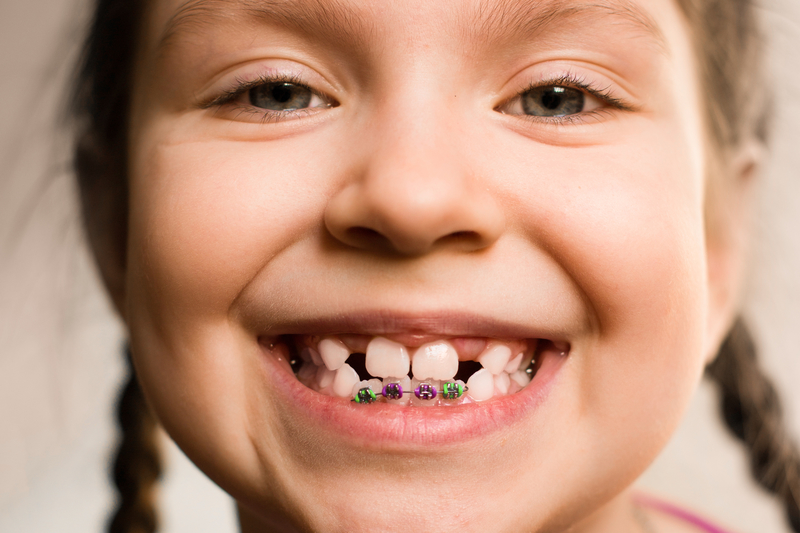
You need to help your child learn how to properly take of their teeth through brushing and flossing. However, having clean teeth isn’t everything. Early orthodontics is needed for some children who have bite and alignment problems that could lead to problems later on in life. Early orthodontics seeks to correct bites to avoid problems with speech, biting, chewing, and more. If done correctly, early orthodontics can set a child on the path to a healthy mouth free of tooth decay and gum disease. Read on for our tips for success with early orthodontics and for protecting the health of small mouths!
Caring for the Baby Teeth
Your child’s teeth are delicate. Help keep them healthy and strong with the following tips:
- Rinse with water before brushing. Teach your child to rinse with water after eating. This will loosen food that may be caught in the braces. Follow rinsing with a thorough brushing. Teach your child how to properly brush their teeth and monitor them after they are able to use a toothbrush on their own. You will have to brush your child’s teeth until around age 3, or until they have the dexterity to brush and floss alone. Make sure they brush long enough, correctly, and several times a day. Brush an infant’s teeth with an infant toothbrush and increase the toothbrush size as they age. Children will need about a pea-size amount of toothpaste and infants will only need toothpaste equal to the size of a grain of rice.
- Floss once a day. Ensure your child is flossing each day or each night. Flossing helps loosen food debris and plaque at and under the gum line that can harden into tartar. Flossing also helps remove food debris from the small, hard-to-reach areas of the teeth that might be difficult to reach with a toothbrush. Flossing takes time to learn, so practice this skill frequently with your child.
- Use a fluoride rinse. Parents should always be the one to administer a fluoride rinse. Rinse with fluoride after brushing and before bed to help keep teeth strong and healthy. This treatment will help prevent tooth decay in your little one.
- Schedule dental visits every 6 months. After your child starts getting teeth, they should visit the dentist for a checkup and cleaning every 6 months. This will help keep your child’s mouth healthy during treatment.
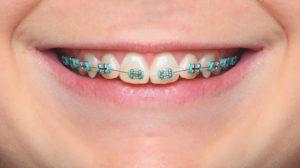
Early Orthodontics
The American Association of Orthodontics recommends that children have their first orthodontic visit between the ages of 7 and 8. Having an examination early-on will prevent the progression of orthodontic issues that can become severe later on in life. Not having your child’s bite checked can lead to problems with their teeth coming in correctly or staying upright. Teeth may form gaps between one another, making speech impediments common and making it more difficult to bite and chew food. Crooked teeth coupled with a misaligned bite also leads to chipped, broken or cracked teeth, as well as a higher risk for tooth decay and gum disease.
With early orthodontics, you are making an investment in your child’s future that will set them up for success the rest of their life. Early orthodontics is different than simply receiving braces as an adult or teenager. We adhere braces to your child’s teeth and then during their treatment we can:
- Observe the progress of incoming teeth
- Monitor facial and jaw development
- Guide incoming teeth into their ideal position
- Detect hidden dental issues
- Reduce the risk of impacted teeth
- Decrease the risk for permanent tooth extractions

Caring for Braces
At each appointment, we will adjust the wires so that a child’s bite will eventually line up correctly. These braces need to be cared for just as much as an adult’s or teenager’s braces. Cleaning the teeth with braces is much trickier, especially for young children, so their success is dependent upon how much parents help them care for their braces.
We suggest the following for having success with your child’s braces:
- Brush after every meal. If food doesn’t have time to sit on the teeth long, then you can prevent stained teeth and reduce the risk for bacteria buildup. This keeps your child healthier.
- Use threadable floss or a floss threader. Don’t let your child skip on their flossing or they could wind up with tooth decay when those braces come off.
- Use a proxabrush or waterpik. A proxabrush is a “Christmas tree brush” that you place between two brackets and below the archwire. Brushing back and forth can give the teeth a better clean. For hard-to-reach places in the mouth, children can also use a waterpik. This is a device that shoots water to dislodge stuck food. Children get a better clean when these two tools are used.
- Avoid hard or sticky foods. These types of foods lead to tooth decay or broken brackets. Avoid hard or chewy candies, chips, ice, apples, popcorn, nuts, corn on the cob, caramel and more.
Does Your Child Need Early Orthodontics?
If you haven’t gone to visit an orthodontist, schedule an appointment today! You can also ask your dentist if they see problems forming with your child’s bite and alignment. However, only an orthodontist can perform child orthodontics. Investing your time in correcting your child’s bite can set them up for success for the rest of their life. To schedule your child’s appointment for early orthodontics, call Belmar Orthodontics today at (303) 225-9016!
How to Choose a Good Orthodontist
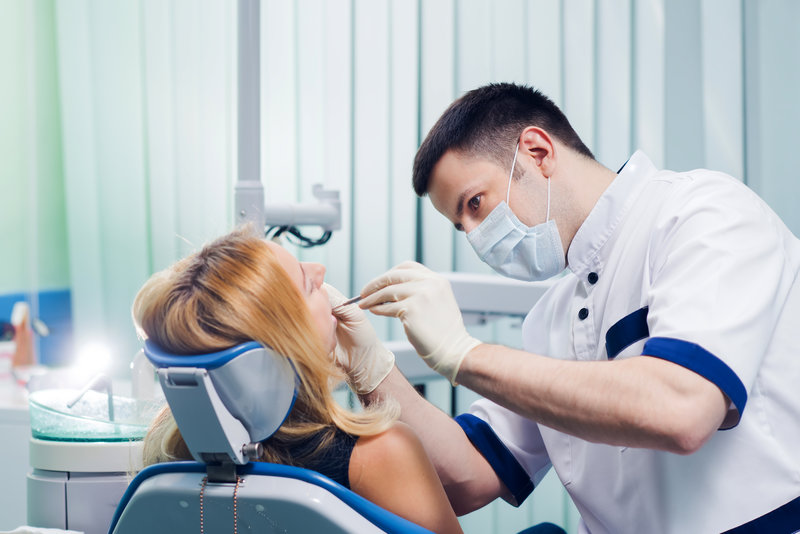
The American Dental Association recommends that your child have their first orthodontic visit between ages 7 and 8 to correct bite and alignment issues. Teenagers, as well, need to visit the orthodontist to correct the alignment of their permanent teeth. How do you know what orthodontist to go to? Choosing an orthodontist is a big decision, as it will determine the health of your teeth and the quality of care you receive. Orthodontists are different than regular dentists and must go through several years more of quality training. You want to look for an orthodontist that has this training. Finding one that can work with children as well as adults is also important. Learn about orthodontists, what constitutes a good one, and what factors you must consider when choosing one!
Choosing a Good Orthodontist
When you choose an orthodontist, you are choosing a person that has had extensive training and years of schooling to take care of your teeth. An orthodontist must complete 4 years of undergraduate training and then be accepted to a 4-year dental school. They then continue a 2-3 year doctorate training to work with patients to correct bite and alignment. Essentially orthodontists are specially-trained dentists that specialize in bite and alignment issues and straightening the teeth. These are services that can last a patient a lifetime. You want to only choose a speciallytrained orthodontist to work on your teeth. Never attempt to straighten your teeth on your own.
A good orthodontist must become certified by the American Board of Orthodontics. They do this through written and clinical exams and then they must recertify often to ensure that their orthodontic training is still at the highest level it needs to be. Another aspect about choosing a good orthodontist is choosing someone that truly cares about your needs and wants you to be as successful as possible. At Belmar Orthodontics, our success is dependent on your success. We try to keep our office up-to-date with the latest state-of-the-art treatment and services to transform your smile into something beautiful in the least amount of time.
Your Braces Options
A good orthodontist will be skilled in several methods of straightening your teeth. We are skilled to provide you more than just traditional metal braces. We also offer the following options for orthodontic care so you can truly choose how your want your straightening treatment to be:
- Incognito Lingual Braces – These are metal braces that are attached to the inside of each tooth. They straighten much light traditional metal brackets, but their hidden apparatus makes them especially appealing for adults and professionals.
- Invisalign – This is a series of transparent aligners that are custom-made for each patient and are changed every 1-2 weeks. This allows a patient to straighten their teeth virtually invisibly. Plus, the aligners are removable for cleaning, eating, sports and similar activities.
- Clear Ceramic Braces – These are braces that mimic metal braces but are made of ceramic material. Even the archwire can be made white like the brackets, helping both to blend into the teeth. Ceramic helps decrease demineralization.
- Retainers – The best way to keep your smile straight is to wear a custom-made retainer after treatment. We can customize retainer trays that you wear each night to keep those pearly whites straight. We can also provide you permanent retainer devices that are attached to the back of your front teeth.
Orthodontic Care for Children
Not all orthodontists work with children or know how to. However, child orthodontics is very important for the health of many children. Children should see an orthodontist between 7 and 8 years old. This is a critical time to correct bite and alignment issues that become severe later on in life. These problems cause speech impediments, problems eating, speaking, chewing and more. A good orthodontist will be one that works well with children and keeps the office environment inviting for them.
Do You Need a Dentist?
An orthodontist does many services to help the health of your teeth, however, they don’t do everything. They are trained just as a dentist is and they know the signs of tooth decay, gum disease and other oral health problems. However, their job is to do orthodontic care, not dental care. That is why they specialized in the field that they did. A good orthodontist will frequently see the signs of tooth decay or gum problems, and a good orthodontist will refer you to a trusted dentist to fix those problems. If you have a cavity or a dental emergency, a dentist is usually the person you want to see instead of an orthodontist.
A dentist received 4 years of training in an undergraduate program. Then, he or she went on to do 4 years of dental school. There they learned services such as the following:
- Comprehensive Exams
- Dental Cleanings
- Sedation Dentistry
- Laser Cavity Detection
- Proper Oral Hygiene
- Oral Cancer Screenings
- Digital X-rays
- Dental Sealants
- Periodontal Treatment
- Scaling & Root Planing
- Sleep Apnea Therapy
- Teeth Whitening
- Root Canal Therapy
- Tooth-Colored Fillings
- Same-Day Crowns/Dental Crowns
The majority of dentists also offer cosmetic dentistry options such as dental implants, cosmetic bonding, dental bridges, porcelain crowns and porcelain veneers. If you want to transform your smile beyond straightening your teeth and correcting bite and alignment, then you want to see a dentist instead of an orthodontist.
Schedule Your Consultation
In Lakewood Belmar Orthodontics orthodontist is a great step in the right direction, as it means you are conscious about your oral health. Orthodontic treatment is a wonderful way to correct a smile and to make it into something beautiful you can keep for life. Studies show that a straighter, more beautiful smile can make you more confident, and others will see you as such as well as more attractive, successful and trustworthy. Who wouldn’t want those things? If you would like to learn more about orthodontic treatment and schedule your free consultation, call Belmar Orthodontics today at (303) 225-9016!
Get Your Braces in Time for Back-to-School

School is just around the corner and it’s time to prepare your peers for your beautiful smile. Braces not only help straighten your teeth, but they can also improve your speech, your appearance and–most importantly–your confidence! New technology gives you more options for adding a little fashion flare to your smile or straightening your teeth discreetly. Learn about all of your amazing options for braces today.
Back-To-School Success
Summer is almost over and it’s back to school time. Is your smile ready? A lot can happen over the summer and each year brings new exciting changes. Getting a straighter, more beautiful smile is something you don’t want to be without as a new year starts off. Did you know that kids with straighter teeth tend to feel more confident in school and around their peers? That confidence can help them get better grades, make more friends, and be more willing to try new opportunities. Every child and teenager alike wants to shine in their own way. You can do that and receive more confidence by getting your braces just in time for school.
In the past, many adolescents saw braces as embarrassing or unattractive. However, studies show that children and teens are receiving braces in much larger numbers than they did in the past. Now, instead of being embarrassing, braces are seen as a luxury for many families and individuals. In times of recession, families even go without necessities to make sure their children receive braces. Braces truly are worth having because of how beneficial they are for boosting self-esteem, confidence and how you’re perceived socially. Investing in them is a great way to help a child as they start off school once more.
Options for Your Braces
We love providing options for our patients at Belmar Orthodontics! Our most popular option for braces for children and teens alike are our traditional metal braces. However, there are other options we provide as well:
- Traditional Metal Braces – This is our most economical option. Our patients love the colorful bands that they can customize their braces with. Each patient can choose a certain color they love every appointment or even do a rainbow of color if they so choose.
- Incognito Lingual Braces – This option is very similar to traditional metal braces, however the braces are worn on the tongue-side of your teeth. We make an impression of your teeth and then custom-make braces that fit the inside of your teeth perfectly. You can straighten your teeth with the perfect hidden apparatus.
- Clear Ceramic Braces – We can provide ceramic braces for our patients. These braces are similar to traditional metal braces, but they are made from ceramic material. The braces blend in with your teeth perfectly as the brackets and even the wires can be made white. Ceramic braces can also decrease demineralization that can happen with metal sometimes.
- Invisalign Teen – This is a version of Invisalign transparent aligners designed with the needs of teenagers in mind. These custom-fit aligners can correct smiles and unevenly-spaced teeth while allowing patients to continue eating, drinking, and cleaning their teeth with ease.
Cleaning At Home
Your braces are something new and exciting. However, they must have proper care to truly work wonders. Brush and floss your teeth often. We recommend brushing and flossing at least twice daily. However, with braces you may want to brush the teeth more than twice a day. After each meal would be best, as food can become trapped in the brackets very easily, where it will then sit on the teeth. Plaque is a sticky, acidic substance that you want to avoid. Plaque is made from the sugars in the food you eat that mix with the bacteria in your mouth. When food is left on the teeth, that plaque can form and begin to erode your teeth.
Not brushing and flossing enough can cause erosion and demineralization that will be obvious once the braces come off. Use special flossers to get in between the teeth sufficiently. Take care of your teeth so that your smile is beautiful and straight without blemishes when your braces come off!
Tips for Success At School
Your braces are easier to manage when you’re prepared. At school, take a mouthguard with you to gym class. You can get injured with braces when playing sports, especially contact sports. A mouthguard will help protect you and your mouth from injury. Be careful what you eat as well. Some foods can damage or break your braces and other foods can get tremendously stuck in the brackets. Some foods to avoid are anything hard, gooey, crunchy or sticky. This includes food items such as gummy bears, fruit snacks, hard candies, chips of any kind, hard vegetables, and nuts. If you really want a food (such as hard fruits and veggies), make sure to cut them up into bite-size pieces. Biting into foods can lodge them into the braces, so be careful with this.
We also have braces kits you can have or tips to make one yourself. Take a kit with you to school that has the cleaning essentials you need: mirror, toothbrush, toothpaste, floss and flossers, wax for pokey wires, etc. If you need a quick cleaning or a quick fix for a wire, you’ll be set!
Your Free Consultation
There never was a better time to straighten your smile! Braces can provide your child the boost of confidence they need to start of the school year right. If you want to schedule your child’s appointment, call our Belmar Orthodontics office today at (303) 225-9016!
How Do Adult and Child Orthodontics Differ?

Advancements in adult and child orthodontics have triggered a rise in adults seeking treatment for oral challenges they have had for years. When deciding to pursue orthodontic treatment, understanding the differences between adult and child orthodontics can help you decide what type of treatment is right for you. Everyone should want their best smile. Feeling confident about your teeth and smile is essential for healthy self-esteem and confidence. You can achieve both of those benefits with braces.
Benefits of Braces
For years, braces have helped millions of people receive a more beautiful smile. About 4 million Americans on average each year are wearing braces. You may think that braces are mostly for teenagers, but you may be surprised to know that about 25% of braces wearers are actually adults. A large portion of those 4 million are also children. Braces benefit people of all ages and it’s never too late to get your own set. Why are braces so important? Straighter teeth keep the mouth in proper alignment and help even out the pressure placed on the jaw each time you talk, bite, eat and more. When the teeth are straighter, they are easier to clean, especially to floss in between the teeth. This is why people with straighter teeth have a reduced risk for oral health problems such as tooth decay and gum disease.
Tooth Decay and Gum Disease
The biggest oral health problems are tooth decay and gum disease. These problems come from lack of good oral hygiene habits. If you skip on brushing and flossing the teeth (or not doing them enough) you may start to have problems. When food sits on the teeth, the sugars from the food you ate (or drank) mix with bacteria in the mouth. This mixture creates a sticky acidic substance called plaque. That plaque works hard to erode your tooth enamel. If it sits on the teeth long enough without being cleaned through brushing or flossing, it will seep into the center of your tooth, called the pulp. This is where that acidic plaque will start to decay your tooth. If left untreated, the problem can become severe. Tooth decay is the most wide-spread childhood disease.
Gum disease is similar to tooth decay, but it has to do with the gums. Plaque is not your friend in this case either. When it sits on the teeth for too long, it can irritate the gums. You may notice your gums begin to turn more red and they may become inflamed. Over time, if good oral hygiene habits are not established, the gums will begin to recede from the teeth. This can eventually cause the teeth to begin falling out. About 64.7 million American adults suffer from some form of gum disease. That’s not even including the number for children! Even though tooth decay and gum disease are so wide-spread, they can both be prevented by brushing and flossing several times a day and by establishing and keeping good oral hygiene habits.
Child Orthodontics
One area we specialize in is child orthodontics. A large portion of the people that wear braces are children. The American Association of Orthodontics recommends that children have their first orthodontic visit between ages 7 and 8. Having an examination early-on helps prevent the progression of orthodontic issues that may be present. In children, we can detect certain orthodontic problems—such as underbite or crossbite—that are present. These problems can be fixed with child orthodontics and other bite and alignment problems such as overbite, openbite and malocclusion. The jaw is still forming in children, so performing child orthodontics at this age can help easily correct problems that are harder to deal with as an adult. Even if your child does not show any signs or symptoms of orthodontic complications, you can still benefit from child orthodontics. Some benefits include:
- Monitoring the facial and jaw development
- Observing the progress of incoming teeth
- Guiding incoming teeth into their proper positions
- Reducing the risk of impacted teeth
- Decreasing the risk for permanent tooth extractions
- Detecting hidden dental issues
Adult Orthodontics
Adult and child orthodontics are very similar. However, it often takes longer to correct bite and alignment problems in adults than it does children or teenagers. This is because the jaw and mouth has stopped growing by adulthood. If bite or alignment problems are severe, an adult may have to look into receiving surgery to correct the problem. Adults also have a few more options when it comes to what kind of braces they would like. Adults and teenagers have the option to choose these types of braces besides traditional metal braces:
- Lingual Braces – These are also known as “Incognito” braces. They are a hidden braces apparatus on the tongue-side of your teeth. Worn on the inside, no one will even know you are wearing braces.
- Invisalign Transparent Aligners – This is a series of removable transparent aligners that are custom-made for your teeth. They can be removed for activities such as eating, drinking, sports and more. Because they are transparent, they are also a secret way for adults and teenagers to discreetly straighten their teeth.
- Clear Ceramic Braces – Made of ceramic material, these braces fit in with the color of your natural teeth. Ceramic material helps reduce the risk for demineralization and staining.
Your New Smile
Whether you are an adult or child, it’s never too late to improve your smile! For people of all ages, a straight smile boosts confidence and self esteem. For adults, that new smile of yours could help you land a job. Studies have also shown that straighter smiles make you appear more confident, successful, attractive and even more trustworthy to others. The benefits of braces are just too good to pass up! If you would like a new smile today, call our Belmar Orthodontics office at (303) 225-9016!
Why Adult Braces Are So Important
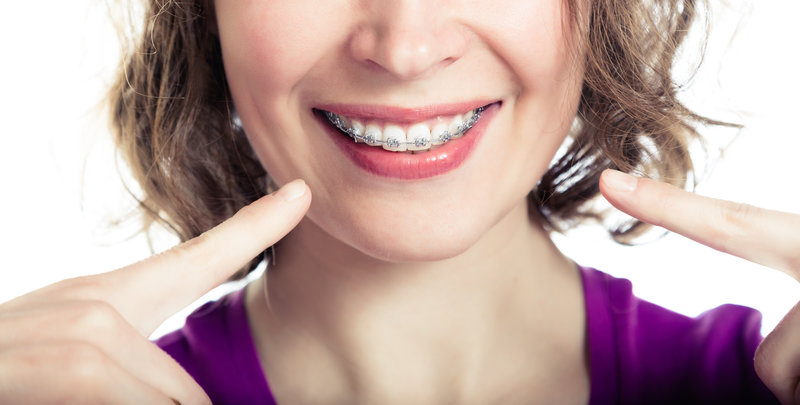
How important are adult braces? Not only do braces enhance your appearance, but they help prevent tooth decay and oral health problems. The American Dental Association tells us that braces are used to correct bite problems and malocclusion. Correcting these problems helps prevent oral health issues such as tooth decay, gum disease, jaw problems and even tooth loss. Proper orthodontic care goes beyond simply improving your oral health. Braces will give you added confidence that will boost performance in all facets of your life. Let us show you just how important braces are and why you should invest in them whether you are an adult or a child!
Braces for Children and Teens
About 75 percent of orthodontic patients are children and teens. Of that number, the majority opt to have traditional metal braces. Traditional metal braces are the most economic choice for orthodontic care if you are looking to improve your smile without breaking the bank. Children can receive braces as early as 7 or 8 years old depending on their needs. The adolescent years are the most common period for receiving braces when the head and mouth are still growing (especially the jaw). When children as young as 7 or 8 receive orthodontic treatment, it is usually to correct problems with alignment or bite that can become severe in later years. This early intervention ensures that teeth come in correctly in a child’s mouth and that the bite is aligned correctly. This will help correct problems with speech, biting, chewing, talking and even physical appearance.
Why Orthodontic Care Is Important
Orthodontic care during the adolescent years is generally used to correct alignment by straightening the teeth. Both bite correction and proper alignment is vitally important to oral health. When the teeth are crooked, problems such as tooth decay and gum disease can easily set in. This is because food becomes trapped in the teeth when you eat and is much harder to remove when the teeth are crooked. Gums can become irritated when plaque sits on the teeth for too long. Over time, plaque-infested gums can become red, swollen and can bleed easily–especially when flossing. Gums can even begin to recede to the point where the teeth fall out. Recession occurs more frequently with teeth that are crooked and harder to clean. Teeth that have been straightened through orthodontic care avoid some of these challenges.
When bite is misaligned, the teeth can come in crooked in a child. Patients may have overbite, underbite, crossbite, openbite or malocclusion. All of these types of misaligned bites will interfere with eating and speaking as well as the physical appearance of the mouth and face. This is because many of the teeth overlap one another abnormally or one jaw protrudes more than the other. Orthodontic care through braces for children and adult braces can correct these problems. Orthodontic treatment through adolescent and adult braces can help ensure that there is enough space for all the teeth to sit comfortably in the mouth.
Other Reasons to Invest in Braces
Are braces something you should invest in? The answer is yes! Whether you seek adult braces or braces for children and teens, you are making a decision that has far-reaching effects. The majority of people will experience crooked teeth at some point. What you decide to do about it is up to you.
Braces—even adult braces—are actually quite desirable today according to reports by the Los Angeles Times, The Washington Post, The Wall Street Journal and more. The amount of adults wearing braces rose 24% between 1989 and 2008 alone and that number has continued to rise. Why? Braces have become more affordable and more attractive. Insurance even covers part of the cost for many patients. Braces are also more comfortable than they were in the past and there are more options for patients seeking orthodontic treatment. The social benefits of braces alone draw people in as well.
Studies About Adult Braces
There have been many studies done about the importance of braces. Invisalign conducted one such study several years ago that recorded more than 1000 responses by pedestrians on the street. These pedestrians were asked to choose from two pictures of people placed side-by-side. Who would they trust more? Who seemed more confident? Respondents did not not beforehand that the comparison was between people with straight smiles and people with crooked smiles. From that study, it was found that those with straighter smiles were perceived as more confident, more successful, more attractive and up to 70% more trustworthy. All from a better, straighter smile!
Proper orthodontic care can also get you ahead when it comes to job interviews and new opportunities. Because a straighter, more beautiful smile has been shown to exude all of the characteristics above, those traits are also perceived in job interviews and during first impressions. Adult braces can help you land that job you’ve wanted and can help you get ahead professionally.
Your Options at Belmar Orthodontics
Traditional metal braces are just that: traditional. This is the most common option chosen by patients when selecting what type of orthodontic care they want. This choice is often popular with children and many teens and has proven through the years to provide exceptional straightening power. Adults and teenagers alike will sometimes avoid needed orthodontic treatment because they find traditional metal braces to be distracting or unattractive. Because of this, we provide you other options when it comes to straightening those pearly whites. These include:
- Incognito Lingual Braces: Metal braces attached to the inside of the teeth that stay hidden.
- Invisalign Transparent Aligners: Transparent aligners that are changed every few weeks to shape your teeth into proper alignment.
- Ceramic Clear Braces: The look of traditional metal brackets made in ceramic form. Both the brackets and wires can be made white to match your natural teeth.
At Belmar Orthodontics, we do all that we can to ensure your mouth stays healthy and your smile bright. Our success is dependent on your success. This is why we offer you so many options when it comes to straightening children’s teeth or investing in adult braces. To learn more about child and adult braces, call our office today at (303) 225-9016!

